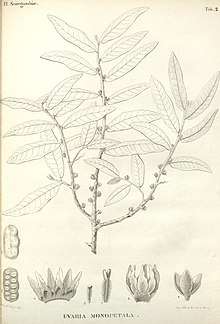Hexalobus monopetalus
Hexalobus monopetalus is a species of plant in the family Annonaceae. It is native to Angola, Benin, Botswana, Burkina Faso, Cameroon, Central African Republic, Chad, Gambia, Ghana, Guinea, Guinea-Bissau, Ivory Coast, Liberia, Malawi, Mali, Mozambique, Namibia, Niger, Nigeria, Senegal, South Africa, Sudan, Tanzania, Togo, Uganda, Zambia, Zaire and Zimbabwe.[3] Achille Richard, the French botanist who first formally described the species, using the basionym Uvaria monopetala, named it after its petals which are fused at their base.[1]
| Hexalobus monopetalus | |
|---|---|
 | |
| Botanical illustration of Hexalobus monopetalus (using the basionym Uvaria monopetala.[1] | |
| Scientific classification | |
| Kingdom: | Plantae |
| Clade: | Tracheophytes |
| Clade: | Angiosperms |
| Clade: | Magnoliids |
| Order: | Magnoliales |
| Family: | Annonaceae |
| Genus: | Hexalobus |
| Species: | H. monopetalus |
| Binomial name | |
| Hexalobus monopetalus | |
| Synonyms | |
|
Hexalobus glabrescens Hutch. & Dalziel | |
Description
It is a tree reaching 8 meters in height. Its petioles are 1 to 2 millimeters long. Its leaves are 4–15 by 2–5 centimeters and come to a point at their tip. Its solitary flowers are axillary. Its sepals are 6 millimeters long, concave, and have silky hairs on their inner surface. Its light yellow petals are 2–2.5 by 1.5 centimeters.[4]
Reproductive biology
The pollen of H. monopetalus is shed as permanent tetrads.[5]
Uses
Bioactive molecules extracted from its fruit have been reported to have antifungal activity in test with Candida albicans.[6]
References
- Guillemin, J.A.; Perrottet, G.S.; Richard, Achille (1930). Florae Senegambiae tentamen,seu, Historia plantarum in diversis Senegambiae regionibus a peregrinatoribus Perrottet et Leprieur detectarum (in French and Latin). Paris: Treuttel et Wurtz. p. plate 2.CS1 maint: unrecognized language (link)
- Cosiaux, A., Couvreur, T.L.P. & Erkens, R.H.J. (2019). "Hexalobus monopetalus. The IUCN Red List of Threatened Species". IUCN Red List of Threatened Species. 2019: e.T132520315A132520532. doi:10.2305/IUCN.UK.2019-3.RLTS.T132520315A132520532.en. Retrieved May 30, 2020.CS1 maint: multiple names: authors list (link)
- "Hexalobus monopetalus (A.Rich.) Engl. & Diels". Plants of the World Online. The Trustees of the Royal Botanic Gardens, Kew. n.d. Retrieved February 8, 2019.
- Engler, A; Diels, L. (1901). Monographieen afrikanischer Pflanzen-Familien und Gattungen VI. Annonaceae (in German and Latin). 6. Leipzig: W. Engelmann.
- Botermans, Marleen; Sosef, Marc S. M.; Chatrou, Lars W.; Couvreur, Thomas L. P. (2011). "Revision of the African Genus Hexalobus (Annonaceae)". Systematic Botany. 36 (1): 33–48. doi:10.1600/036364411X553108. ISSN 0363-6445.
- Malebo, Hamisi M.; Jonker, Stephan A.; Waibel, Reiner; Nkunya, Mayunga H. H. (2014). "Diprenylated Indole Alkaloids from Fruits of Hexalobus monopetalus". Natural Products and Bioprospecting. 4 (2): 101–105. doi:10.1007/s13659-014-0010-x. ISSN 2192-2195. PMC 4004831. PMID 24859178.
